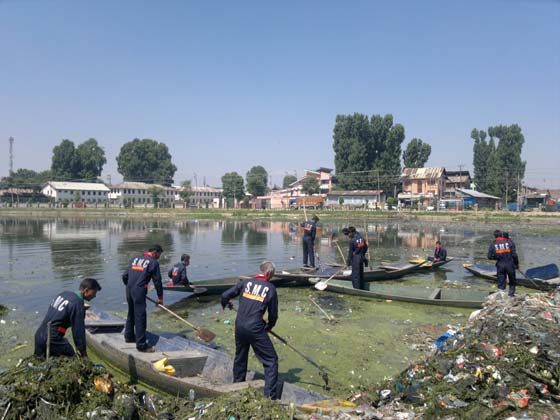Neglect and Pollution Threaten the Survival of Dal Lake’s Crucial Lagoon
By: Javid Amin
Srinagar 14 April 2025: Nestled in the labyrinthine alleys of Srinagar’s historic Downtown, Brari Nambal Lagoon was once a shimmering oasis where Mughal emperors bathed, poets found inspiration, and fishermen thrived. Today, it is a shadow of its past—a murky pool of stagnation, choked by plastic waste and haunted by the stench of neglect. Once the “kidney” of Dal Lake, filtering its waters and maintaining ecological balance, Brari Nambal now gasps for survival. Its demise is not just an environmental tragedy but a cultural loss for Kashmir, exposing systemic failures in conservation and governance. This is the story of a water body in crisis and the urgent battle to reclaim its soul.
01: Echoes of History – The Lagoon’s Golden Era
From Budshah’s Steam Baths to Mughal Gardens
Brari Nambal’s history is intertwined with Kashmir’s identity. In the 14th century, Sultan Zain-ul-Abidin, revered as Budshah (the Great King), commissioned ornate hamams (steam baths) along its banks, drawing from its crystal-clear waters. Mughal rulers later immortalized the lagoon in chronicles, marveling at its role in cooling Srinagar’s summer heat. For centuries, it served as a hydrological linchpin, channeling excess water from Dal Lake into the Jhelum River via the Nalla Mar channel.
Cultural Legacy:
- Fishing Traditions: Local communities relied on its abundant fish stocks, with species like Schizothorax sustaining livelihoods.
- Spiritual Hub: Adjacent shrines, like Baba Demb, attracted pilgrims who revered the lagoon’s purity.
02: Anatomy of a Collapse – How Brari Nambal’s Ecosystem Unraveled
The 1970s: A Tipping Point
The lagoon’s downfall began with the reckless urbanization of the 1970s. Authorities filled the Nalla Mar channel to expand roads and housing, severing Brari Nambal’s natural outflow. Without circulation, the lagoon turned stagnant, triggering a cascade of ecological disasters:
Key Factors in Decline:
- Hyper-Eutrophication: Nutrient overload from sewage and fertilizers sparked algal blooms, depleting oxygen and killing aquatic life.
- Encroachment Chaos: 40% of the lagoon’s perimeter was lost to illegal shops and settlements, shrinking its area from 50 hectares to under 15.
- Trash Tsunami: Over 2 tons of plastic waste enter monthly from scavengers and unchecked dumping.
Scientific Snapshot:
- Water Quality Index (WQI): Below 30 (classified as “severely polluted”).
- Biodiversity Loss: Fish populations declined by 90%, migratory birds abandoned habitats.
03: Government Promises vs. Ground Realities
The Broken Vows of AMRUT and PMDP
Under flagship schemes like the Atal Mission for Rejuvenation and Urban Transformation (AMRUT) and Prime Minister’s Development Package (PMDP), ₹14.7 crore was allocated for Brari Nambal’s revival. Projects included dredging, walkways, and “eco-tourism” infrastructure. Yet, experts call these efforts cosmetic:
Critical Flaws:
- Engineering Over Ecology: Focus on concrete pathways ignored water quality. Dredging removed silt but failed to stop sewage inflows.
- Corruption & Mismanagement: Contractors allegedly cut corners, leaving de-silting incomplete.
Voices from the Ground:
“They built a park but left the lagoon to rot. It’s like painting a house on fire.” – Dr. Aasim Fazili, Ecologist
04: Pollution, Encroachment, and Social Inequity
The Human Cost of Neglect
Brari Nambal’s crisis mirrors Srinagar’s urban decay. Marginalized communities, lacking waste disposal options, dump trash into the lagoon. Meanwhile, politically connected builders flout laws to erect structures on its banks.
Case Study: Baba Demb Slums
- Health Impacts: Rising rates of skin diseases and respiratory illnesses linked to contaminated waters.
- Economic Loss: Fishermen like Abdul Rashid report incomes plummeting from ₹20,000 to ₹2,000 monthly.
05: Global Lessons – Can Brari Nambal Mimic Success Stories?
From London’s Thames to India’s Chilika Lake
Globally, degraded water bodies have been resurrected through science and community action:
- Thames River Revival: Once declared “biologically dead,” London’s Thames now hosts seals and fish, thanks to sewage treatment upgrades.
- Chilika Lake, Odisha: Restoration of tidal flows increased fish yields by 200%, boosting local economies.
Adaptable Strategies for Brari Nambal:
- Bioremediation: Introduce wetland plants like Phragmites to absorb pollutants.
- Decentralized Sewage Treatment: Install low-cost STPs in surrounding areas.
06: A Blueprint for Revival – Science, Policy, and People
A 5-Point Rescue Plan
- Restore Natural Hydrology: Reopen the Nalla Mar channel and create artificial inlets for Jhelum River water.
- Community-Led Monitoring: Train locals to test water quality and report pollution.
- CSR Partnerships: Engage corporations like J&K Bank in funding bioremediation projects.
- Eco-Tourism Done Right: Build floating wetlands and birdwatching towers, generating jobs.
- Legal Hammer: Demolish encroachments under the Water (Prevention and Control of Pollution) Act, 1974.
07: The Stakes – Why Brari Nambal Matters Beyond Kashmir
A Litmus Test for India’s Environmental Conscience
If a 15-hectare urban lagoon cannot be saved, what hope exists for Dal Lake (1,200 hectares) or the Ganga? Brari Nambal is a microcosm of India’s water crisis, testing the balance between development and sustainability.
The Ripple Effect:
- Dal Lake’s Fate: Without Brari Nambal’s filtration, Dal’s waters grow filthier, threatening a ₹500-crore tourism industry.
- Climate Vulnerability: Stagnant water worsens urban flooding, as seen in 2014 Srinagar deluge.
Bottom-Line: A Call to Reclaim Kashmir’s Soul
Brari Nambal is more than a lagoon—it’s a symbol of Kashmir’s resilience. Saving it demands more than funds; it requires a collective awakening. Citizens must shun plastic, officials must enforce laws, and corporations must invest in green solutions. As the sun sets over Srinagar, the lagoon’s murky waters whisper a plea: Will we let history remember us as the generation that watched it die?



